In the realm of Software as a Service (SaaS), hidden fees can dramatically inflate the overall cost of ownership, often catching customers off guard. To navigate this complex landscape, it is vital for users to seek transparency by requesting detailed pricing information and engaging with service contracts. By doing so, customers can uncover potential hidden charges and make more informed decisions about their software investments.
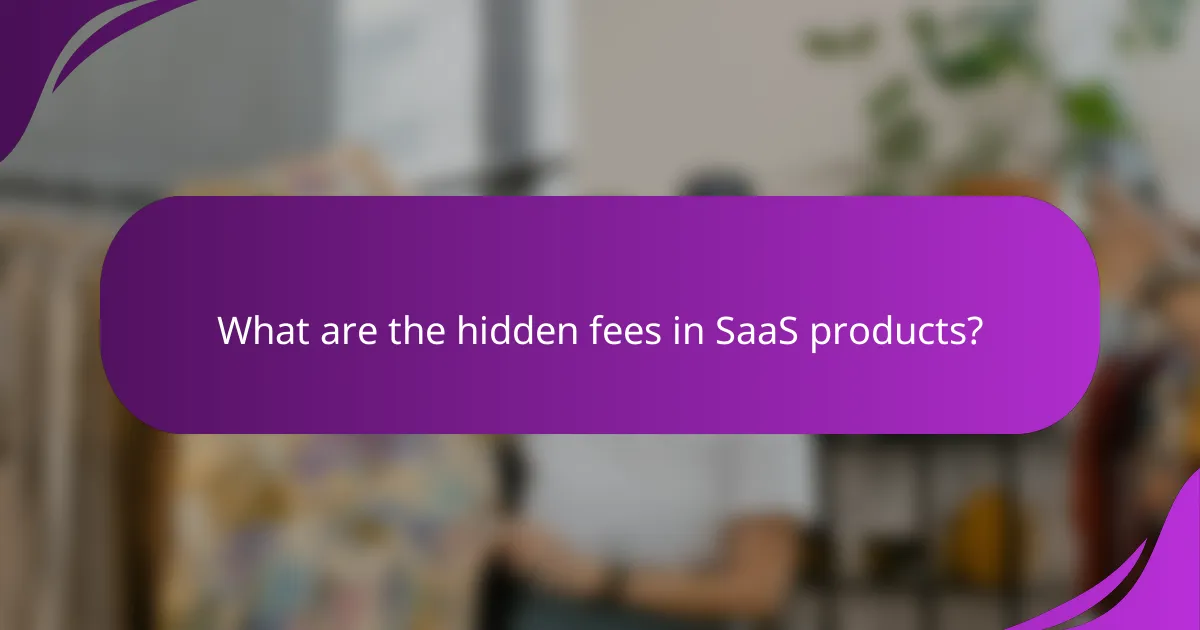
What are the hidden fees in SaaS products?
Hidden fees in Software as a Service (SaaS) products can significantly increase the total cost of ownership. These fees often include charges that are not immediately apparent during the initial pricing discussions, making it essential for customers to be aware of them.
Setup fees
Setup fees are one-time charges that cover the initial configuration and implementation of the software. These costs can vary widely, typically ranging from a few hundred to several thousand dollars, depending on the complexity of the service and the level of customization required.
Before committing to a SaaS product, inquire about any setup fees and what they include. Understanding these charges upfront can help avoid unexpected costs later on.
Usage-based charges
Usage-based charges are fees that depend on how much you use the service, such as the number of users, transactions, or data storage. These fees can lead to higher costs if your usage increases unexpectedly.
To manage these charges effectively, monitor your usage patterns and set limits if possible. Many providers offer tiered pricing models that can help you predict costs based on anticipated usage.
Cancellation fees
Cancellation fees may apply if you decide to terminate your subscription before the contract ends. These fees can vary, sometimes amounting to a percentage of the remaining contract value or a flat fee.
Always review the cancellation policy before signing up. Understanding the terms can help you avoid penalties if you need to exit the service early.
Upgrade costs
Upgrade costs refer to the fees associated with moving to a higher tier of service or adding new features. These costs can be substantial, especially if they involve additional user licenses or advanced functionalities.
When considering upgrades, evaluate whether the additional features justify the costs. Compare the benefits against your current needs to make an informed decision.
Support fees
Support fees are charges for customer service beyond basic assistance. Some SaaS providers offer different levels of support, with premium options costing more for faster response times or dedicated account managers.
Assess your support needs carefully. If you anticipate requiring extensive help, it may be worth investing in a higher support tier to ensure timely assistance when issues arise.
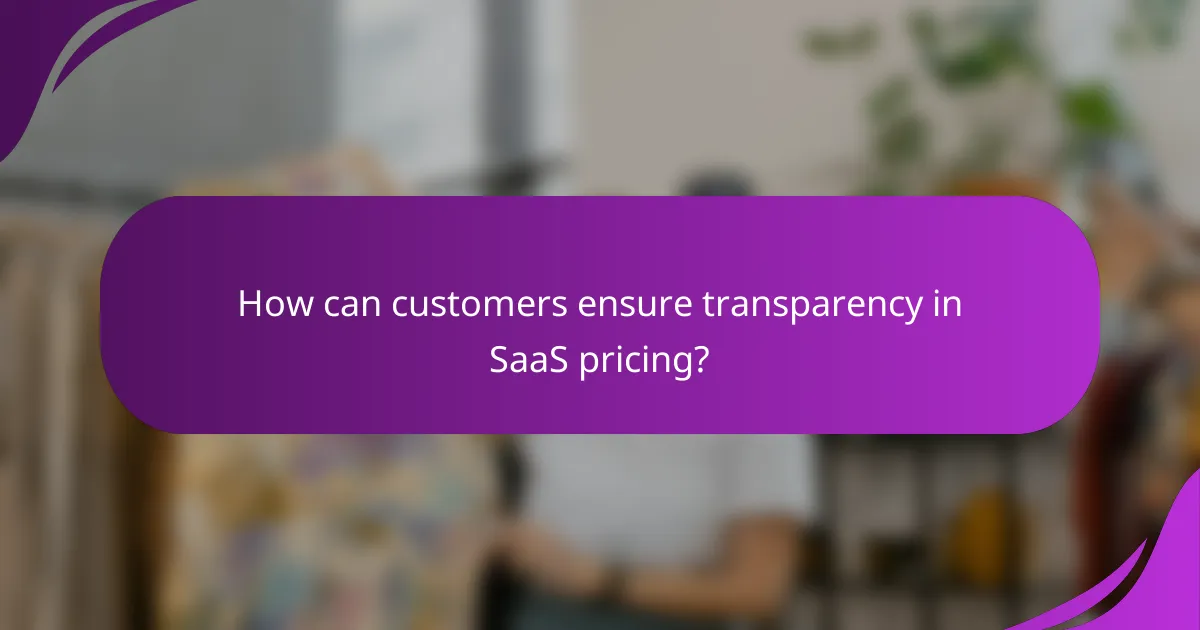
How can customers ensure transparency in SaaS pricing?
Customers can ensure transparency in SaaS pricing by actively seeking detailed information about the costs involved and understanding the potential hidden fees. This involves asking for comprehensive pricing breakdowns, reading customer feedback, and comparing different providers to make informed decisions.
Request detailed pricing breakdowns
Requesting a detailed pricing breakdown is essential for understanding the full cost of a SaaS product. This should include not only the base subscription fee but also any additional charges for features, user licenses, or support services.
When asking for a breakdown, inquire about potential extra costs such as overage fees, setup charges, or annual price increases. A transparent provider will be willing to share this information upfront.
Read customer reviews
Customer reviews can provide valuable insights into the true cost of a SaaS product beyond the advertised price. Look for reviews that specifically mention pricing experiences, including any unexpected fees or charges.
Utilize platforms like G2, Capterra, or Trustpilot to gather a range of opinions. Pay attention to patterns in feedback, as consistent mentions of hidden fees can indicate a lack of transparency.
Compare multiple SaaS providers
Comparing multiple SaaS providers is crucial for identifying the best value for your needs. Create a comparison chart that includes pricing, features, and any additional costs associated with each option.
Consider not only the initial price but also the long-term costs, such as renewal rates and potential price hikes. This comprehensive approach will help you avoid surprises and choose a provider that aligns with your budget and requirements.
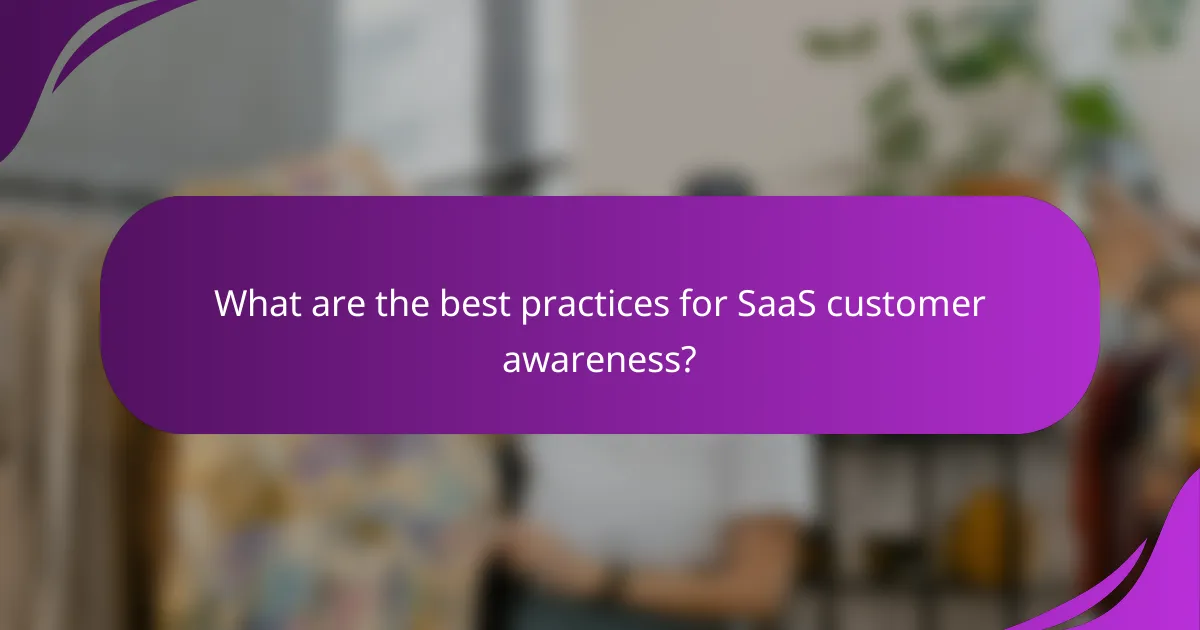
What are the best practices for SaaS customer awareness?
To enhance customer awareness in the SaaS landscape, it is crucial to actively engage with service contracts, customer support, and user communities. These practices help identify hidden fees, clarify service terms, and foster a better understanding of the software’s capabilities.
Regularly review contracts
Regularly reviewing your SaaS contracts is essential to ensure you understand the terms, including pricing structures and potential hidden fees. Look for clauses related to renewal rates, service level agreements, and any penalties for early termination.
Set a schedule to review contracts at least annually or whenever there are significant changes in your business needs. This proactive approach can help you avoid unexpected costs and ensure that the service continues to meet your requirements.
Engage with customer support
Engaging with customer support can provide valuable insights into the SaaS product and its features. Use support channels to ask questions about billing practices, service updates, and troubleshooting issues. This interaction can also reveal any additional costs associated with premium features or support tiers.
Consider keeping a log of your interactions with customer support to track responses and identify any recurring issues. This documentation can be useful for future reference and can help in negotiating better terms if needed.
Participate in user communities
Participating in user communities allows you to connect with other customers and share experiences regarding the SaaS product. These communities often provide insights into best practices, tips for maximizing value, and warnings about potential pitfalls.
Look for forums, social media groups, or official user groups where you can ask questions and learn from others. Engaging with peers can enhance your understanding of the service and help you make informed decisions about your usage and budget.
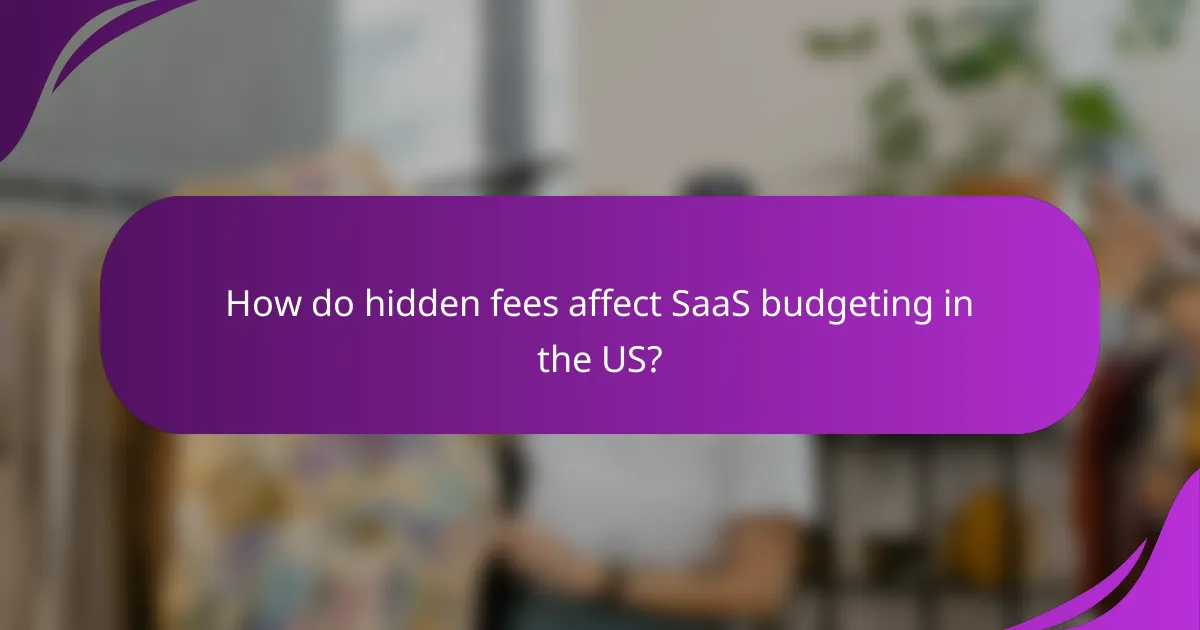
How do hidden fees affect SaaS budgeting in the US?
Hidden fees can significantly disrupt SaaS budgeting in the US by inflating the total cost beyond initial estimates. These fees often arise from add-ons, overages, or service charges that are not clearly disclosed upfront, leading to unexpected financial strain.
Impact on total cost of ownership
The total cost of ownership (TCO) for SaaS products includes not only the subscription fee but also any hidden fees that may arise. For instance, a service might advertise a low monthly rate but charge extra for essential features like customer support or additional storage. This can increase the TCO by 20% or more, depending on usage patterns and service requirements.
When evaluating SaaS options, it’s crucial to consider all potential costs, including those that may not be immediately apparent. Requesting a detailed breakdown of fees from providers can help clarify the full financial commitment.
Budgeting for unexpected expenses
To effectively budget for unexpected expenses associated with hidden fees, businesses should allocate a contingency fund, typically around 10-15% of the expected SaaS costs. This buffer can help absorb any surprises that arise from additional charges or service upgrades.
Regularly reviewing SaaS usage and costs can also help identify patterns that lead to hidden fees. For example, if a team consistently exceeds the allotted user count or storage limits, proactive adjustments can prevent budget overruns. Establishing clear usage policies and monitoring compliance can mitigate these risks.

What criteria should businesses use to evaluate SaaS providers?
Businesses should evaluate SaaS providers based on transparency in pricing, customer support quality, and the overall value offered. These criteria help ensure that companies select a provider that meets their needs without hidden costs or inadequate assistance.
Transparency in pricing
Transparency in pricing is crucial when evaluating SaaS providers. Look for clear pricing structures that outline all costs, including subscription fees, additional features, and potential overage charges. Providers that offer straightforward pricing models, such as flat-rate or tiered pricing, can help businesses budget more effectively.
Consider asking for a detailed breakdown of costs and any potential hidden fees. For example, some providers may charge for customer support or data storage beyond a certain limit. Understanding these aspects can prevent unexpected expenses and ensure that the chosen service aligns with the company’s budget.
Customer support quality
The quality of customer support is a vital factor in selecting a SaaS provider. Evaluate the availability of support channels, such as live chat, email, or phone assistance, and the responsiveness of the support team. Providers that offer 24/7 support are often better equipped to handle urgent issues that may arise outside of regular business hours.
Additionally, consider the level of expertise and training of the support staff. Reading customer reviews and testimonials can provide insights into the effectiveness of the support offered. A provider with a solid reputation for customer service can significantly enhance the overall user experience and minimize downtime.
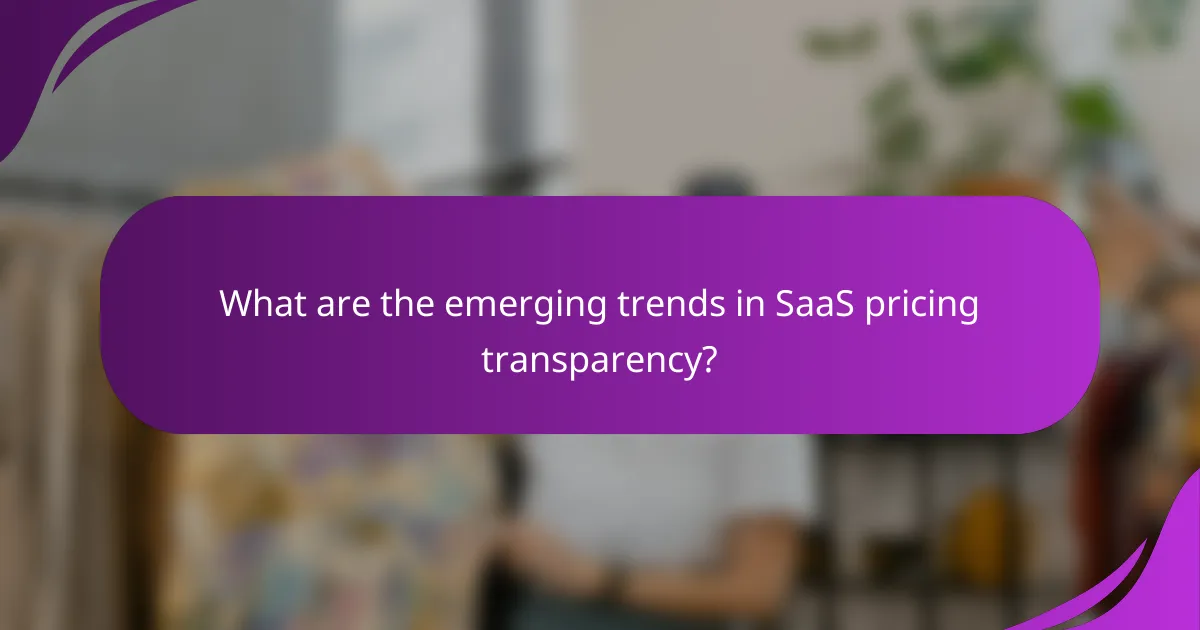
What are the emerging trends in SaaS pricing transparency?
Emerging trends in SaaS pricing transparency focus on clearer communication of costs, including hidden fees and pricing structures. Companies are increasingly adopting straightforward pricing models and providing detailed breakdowns to enhance customer awareness and trust.
Increased clarity in pricing structures
Many SaaS providers are moving towards simplified pricing models that clearly outline what customers will pay. This includes eliminating complex tiered pricing and offering flat-rate or usage-based pricing. Such transparency helps customers understand their potential costs better and make informed decisions.
Disclosure of hidden fees
Transparency around hidden fees is becoming a priority for SaaS companies. Providers are now more likely to disclose additional costs upfront, such as setup fees, maintenance charges, or costs for exceeding usage limits. This shift allows customers to budget accurately and avoid unexpected expenses.
Customer feedback and engagement
Companies are increasingly seeking customer feedback on pricing practices to enhance transparency. Engaging with users through surveys or forums allows SaaS providers to understand customer concerns and adjust their pricing strategies accordingly. This responsiveness fosters a sense of trust and loyalty among users.
Regulatory influences on pricing transparency
Regulations in various regions are pushing SaaS companies to adopt more transparent pricing practices. For example, the European Union has implemented guidelines that require clearer communication of pricing terms. Compliance with such regulations not only helps companies avoid penalties but also builds customer confidence.
